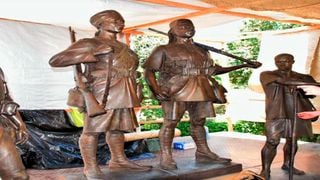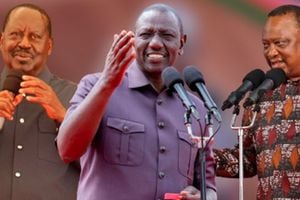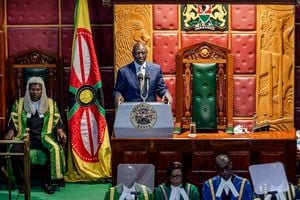
Mombasa World War I African memorials in Mombasa.
| File | Nation Media GroupNews
Premium
Despised in life and death: Story of African world war fighters
When World War I broke out, Voi in Taita Taveta became the overnight headquarters of the High Command of the conflict that happened between 1914 and 1918.
African men, who had sat in sullen clusters in dozens of market centres across British East Africa (then comprising Kenya, Uganda and Somaliland) as European recruiting officers recorded their names were eventually sent to Voi by train.
Due to coercion and blackmail, they had joined the King’s African Rifles to fight an enemy they did not quite know and for a king (George VI) they had never seen much less heard of.
In their hundreds of thousands, they marched to defend the land against German aggression from right across the border in Tanganyika (now Tanzania).
The squalor of their camps and the wretched conditions of the military establishment claimed African lives by the tens of thousands, many falling without seeing actual war action and more dying from diseases, exhaustion and starvation.
Unmarked mass graves
And what did the British do? They decided that the dead Africans could be buried in unmarked mass graves and, worse, never bothered to inform their families on the fate of their loved ones.
Today, one such mass grave in Voi is overgrown with thorny scrub and lies right next to the neat, orderly rows of headstones of the European dead.
In death as had been in life, the British insisted that they were not to be mingled with Africans and the war grave in Voi, maintained by the Commonwealth War Graves Commission (CWGC), lies as a testament to the shame of British racial attitudes despite the immense contribution the Africans made to their success in that war.
The graveyard bearing the remains of British soldiers is fenced off and small pebbles spread evenly underneath the short, rectangular headstones that immortalise the fallen soldiers whose names they bear. In a sharp contrast, it was a mongrel’s send-off for the African soldiers, who were interred across the fence, in the open, where dogs pee.
It’s been more than a century and the Imperial War Graves Commission (IWGC), the institution formed to right the racial injustices of the past, has not only failed at it but a new report has found it culpable for advancing racism, against their founding principle of equality of treatment in death.
IWCG was founded in 1917 to commemorate in perpetuity the men and women of the British Empire who lost their lives in WWI. It would later extend its mandate to incorporate WWII and other victims of imperial conflicts.
The graves in Voi, Taveta, and Maktau in Taita Taveta County and the Nairobi war memorial are part of 23,000 sites in more than 150 countries across the world that are maintained by CWGC. The sites preserve the memory of more than 1.7 million Commonwealth citizens who died in those conflicts.
Online database
Apart from maintaining the cemeteries and memorials, the commission is tasked with managing an online database with the names and details of those in its care.
Some memorials have moving worded epitaphs on them, such as the famous one by British poet John Maxwell Edmonds, “When you go home, tell them of us and say, For your tomorrow, we gave our today”.
The 2021 document, “Report of the Special Committee to Review Historical Inequalities in Commemoration”, noted that whereas IWCG needed to commemorate all heroes of war identically, irrespective of an individual’s rank in social or military life, their race or religion, they had given priority to the British.
“In conflict with the organisation’s founding principles, it is estimated that between 45,000 and 54,000 casualties (predominantly Indian, East African, West African, Egyptian and Somali personnel) were commemorated unequally,” says the report by a14-member committee of independent experts and community representatives.
Identify inequalities
The committee was commissioned in December 2019 by the same indicted Commonwealth body and tasked to analyse the historical actions and identify inequalities in the way the organisation commemorated the dead of the British Empire from the two world wars.
“The IWGC’s commitment to uniformity in the handling of commemoration – and therefore equality in death – had geographical limits. For imperial forces who died outside Europe, but particularly across Africa, the Middle East and India, treatment often differed.
“When working in these theatres, the IWGC categorised the dead into the following groups: 1) those who were ‘white’ (often used interchangeably with ‘European’), West Indians, South African ‘coloureds’ and Chinese; 2) Indians and 3) all other ethnicities, generally referred to as ‘natives’,” the drafters said.
The committee explained further, “For some, rather than marking their graves individually, as the IWGC would have done in Europe, these (black) men were commemorated collectively on memorials. For others who were missing, their names were recorded in registers rather than in stone.”
The cemeteries and memorials in Europe are the most accessible and most visited and they receive a majority of the commission’s resources, a demonstration of the importance they are accorded by the organisation at the expense of the other more than 20,000 sites.
“Despite the global nature of the war and the IWGC’s worldwide commitment, it is clear the Commission still prioritized the Western Front battlefields,” the report says.
It cited a case from January 1920, where George Evans – the officer commanding the Graves Registration Unit in East Africa and soon to be the IWGC’s deputy director of works there – outlined that around 95 per cent of European burials had been located and supplied with temporary metal crosses.
Not adequately marked
He had said that the same treatment had been impossible for Indians and Africans, largely because they had not been adequately marked during the war.
It is estimated that up to 300,000 casualties in East Africa today are commemorated by nameless memorials, the report states. As a result, contemporary attitudes towards non-European faiths and differing funerary rites, and an individual’s or group’s perceived ‘state of civilisation’, influenced their commemorative treatment in death.
Compared with other war memorials and cemeteries in Kenya, racial segregation is more apparent in Voi, where, during commemorations, focus is given to white soldiers and their families invited and honoured as the graves of African soldiers remain with no individuality.
The Nairobi cemetery on Ngong Road, for instance, is always well-manicured. It is now the largest war cemetery in East Africa, set up by military installations in 1941, and contains about 2,000 similar headstones engraved with the identities of the slain men and women - African, European and Asian.
Unlike the Voi cemetery of WWI combatants, the Nairobi yard honours the spirits of their WWII counterparts whose bodies are buried elsewhere. On the right-hand side as you enter the Nairobi memorial, the whitish, waist-high tombstones bear the names of black soldiers, with those of their white counterparts on the left and the Indians centrally placed at the far end of the garden.
WWII deaths
In the second war alone, up to 300,000 Africans died of the half a million recruits drawn from the territories of British East Africa (now Kenya), German East Africa (now Tanzania, Burundi, Rwanda), Portuguese East Africa (now Mozambique), Uganda and Zanzibar.
The Africans at the warfront were fighting two enemies at a go - the brutal foes and the systemic racism and prejudice from the Europeans who were supposed to be their comrades. This was demonstrated in the beatings many received though that treatment had been outlawed in the army.
They also received less pay – a third of what European soldiers got. The same was seen in the war gratuities, with Europeans taking home three times what the African soldier made.
An African soldier in the lowest rank of private, for instance, earned a gratuity of Sh3.50 for every month they served, compared with Sh10 given to European personnel of similar rank. Asians, who were considered superior in race to the Africans, earned Sh7.50 for every month served in the British army.
Prof Timothy Parsons of Washington University-St Louis says, “Different levels of compensation meant that the colonial regime placed different value on African soldiers compared to their European counterparts, who were considered more civilised and therefore more deserving.”
He says that when the war ended, the British system started “explosive propaganda” reminding the African soldiers that they had only played a small role in the victory and therefore shouldn’t have high expectations.
Home empty-handed
But even the little compensation they were made to expect didn’t get to their hands. The African soldiers who survived the gruelling experience ended up coming home empty-handed, and the families of those who perished also never received any compensation.
On the other hand, their European counterparts received huge tracts of land for their participation in the war
Eusebio Mbiuki, a WWII veteran, said, “When I came out, they gave me nothing. They should have known how much we had helped them. They should have given me something, but that was not the case. I returned home just like that.” He spoke in 2019 in an Al Jazeera documentary, “The Forgotten Heroes of Empire”.
In the 2021 report, the committee made 10 recommendations around three central themes: first, to extend geographically and chronologically the search in the historical record for inequalities in commemoration and act on what is found.
Secondly, it wants the commission and the nations to renew the commitment to equality in commemoration through the building of physical or digital commemorative structures.
Finally, it talked of the need to “acknowledge and accept this difficult history and share it with all the communities of the former British Empire touched by the two world wars”.






